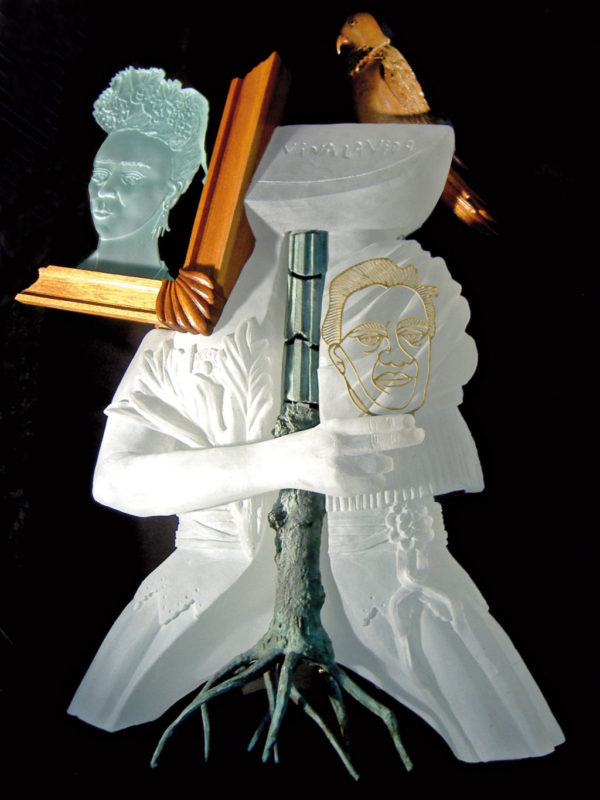Viva la Vida (Frida Kahlo)
MaterialsSandblasted carved glass, cast glass, bronze, wood, and laser-cut glass
CollectionFred and Sharon Shomer, AZ
Frida Kahlo, the Germano-Mexican painter was best known for her numerous self-portraits and her tempestuous life with the equally famous Mexican painter, Diego Rivera. Victim of a terrible accident in her late teens, she suffered a life of great pain with a damaged spinal column and pelvis. Because of this accident she underwent 35 operations to her back, right leg, and right foot. This same right leg was also somewhat withered by a bout of polio contracted when she was 6 years old.
She began painting to occupy her time during the immobilization required by the accident. Greatly influenced by indigenous Mexican culture she combined its symbols and exotic colors with her own self-image. She said, “I paint myself because I am so often alone and because I am the subject I know best”. Kahlo met her future husband in her early 20’s when she asked him for advice about her career. She and Diego were married in 1929, wildly in love yet their marriage was fraught with infidelity on both sides. Frida and Diego’s many affairs were the subject of legend and her wild sexuality included both men and women on an equal basis. The couple divorced in 1939 but remarried a year later.
Actively involved in politics and the plight of the poor, Frida often lied about her birth date so that it would coincide with the beginning of the Mexican Revolution. She and Diego were hosts to Leon Trotsky and his wife after they had fled the Russian Stalinist regime. Frida died in 1954 at the age of 47 under somewhat clouded circumstances (pulmonary embolism or suicide).
In my sculpture the torso with its partially exposed right breast and traditional Mexican dress symbolize her openness and her desire to cover her deformities. The broken column a device Frida used to represent her accident, and the tree as it plunges into the soft earth of Mexican culture its tangled roots become the vaginal symbol of her sexuality. She borrowed the symbol of the parrot from the Hindu culture where they are considered bearers of the god Kama and serve as an erotic indication of her many lovers. Diego holds a prominent position, yet we see that in his transparent aspect she won’t let him dominate the scene. Finally, I have chosen to use the image of Frida herself from a compilation of her self-portrait paintings rather than from photographs.
